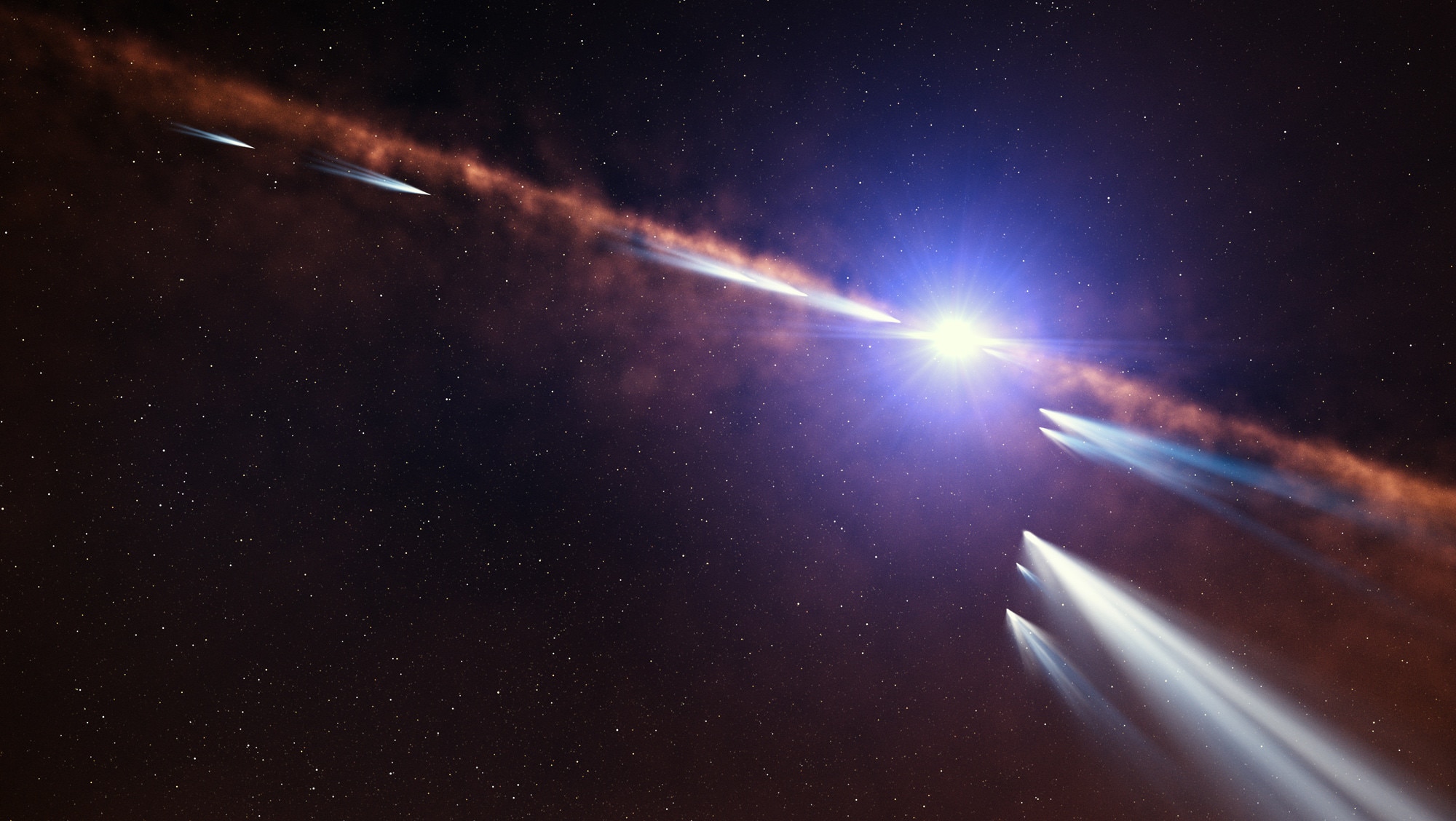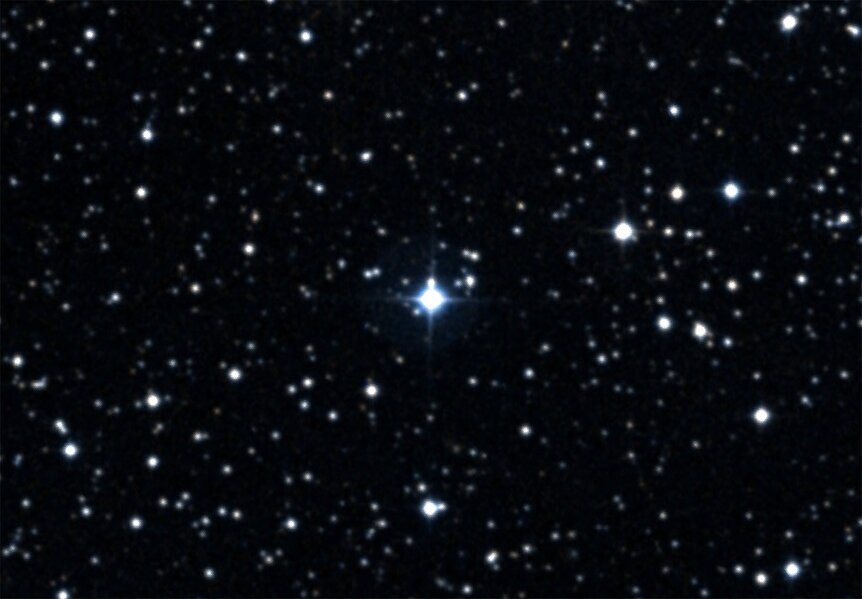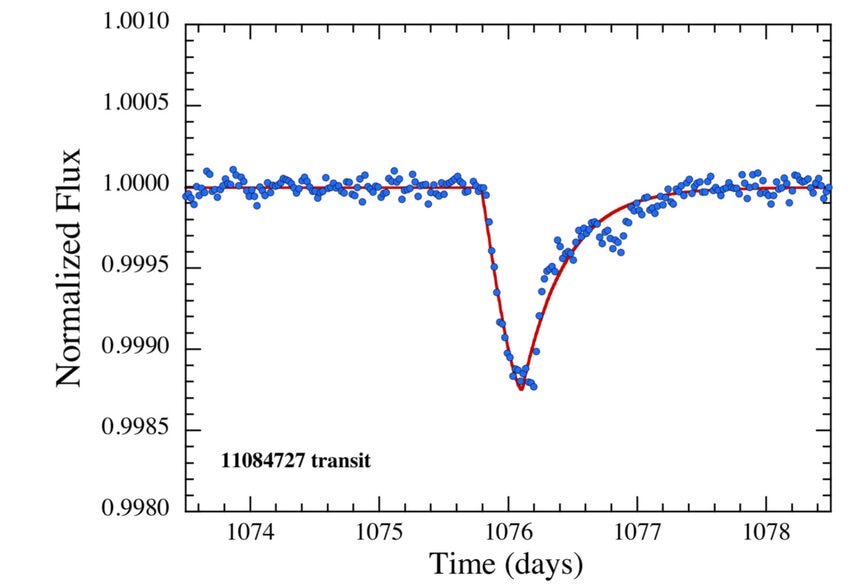Create a free profile to get unlimited access to exclusive videos, sweepstakes, and more!
Exocomets detected orbiting nearby stars. In other words: alien comets!

Since the first confirmed discovery of exoplanets — planets orbiting other stars — in 1992, we've found more than 3,700 of them (and counting). That's a lot of planets! Even before that first one was found, I think pretty much any astronomer would have assumed they were out there, but that they were just hard to see. After all, the Sun doesn't seem all that special, so if planets formed here, they probably formed out there, too, when other stars were born.
And now we know that's true! But taking that farther, it seems logical to assume that these planets have moons, too (they'd be pretty hard to spot, though some folks are looking), and that these other alien systems would have asteroids and comets, as well. We've seen some indications of them using various methods, but never using the transit method, the way the vast majority of exoplanets are found.
Until now. A team of astronomers has found excellent evidence of multiple exocomets orbiting a star 815 light-years away, and perhaps another exocomet orbiting a different but similar) star 850 lights from us.
The alien comets were found in data taken by the Kepler telescope, which spent several years staring at 150,000 stars in one spot in the sky. It was looking for exoplanet transits, a teeny dip in a star's light if an orbiting planet happened to pass directly between us and it. That only happens if the planet's orbit is almost exactly edge-on as seen from Earth, which is why it looked at so many stars. The more you look at, the more likely the geometry will work out.
The data Kepler produces are what are called light curves, graphs of a star's brightness versus time. Usually stars produce a steady amount of light, or it may fluctuate a bit if it's a variable star of one kind or another. But if a planet transits, a small dip (usually less than 1% of the star's total brightness) appears. The depth of the dip depends on lots of things, including the size of the star, the size of the planet, and so on. It's essentially a mini-eclipse, seen from hundreds or thousands of light-years away!
The shape of the dip tells you a lot, too. For example, a transit right across the middle of a star from a smallish planet looks like a symmetric U with very steep sides and a flat bottom; the starlight drops as the planet moves onto the star's face, then stays steady at some lower amount until the planet moves all the way across, upon which it brightens again. The profile of the transit can have different shapes, but in general it's symmetric; the fall and rise have the same shape.
When this team of astronomers looked at the star KIC 3542116, though, they spotted decidedly asymmetric dips. Six of them, in fact! Three were about the same depth (about 0.1% of the star's light blocked), and another set of three a bit shallower (0.05% blocked).
As soon as they saw the fang-shaped profile, they knew they had something special. Still, first they made sure their data weren’t contaminated by the legion of issues that can mess of the observations: starspots (sunspots, but on another star), known stellar variability, camera detector issues, and more. Once they eliminated all the known potential problems, they were left with one conclusion*: exocomets.
As soon as I saw the light curves I got a chill: The shape of them really looks like comets, and that's because of their tails.
A comet is a big ol’ chunk of rock and ice, usually several to several dozen kilometers across. Our own local versions (and by extrapolation, most of them around other stars, too) tend to orbit the Sun on long ellipses, and when they get close they warm up. This sublimates the ices (turns them directly from a solid into a gas) on the surface, which releases that gas into space along with lots of debris, from boulders down to dust grains.
The pressure from sunlight pushes on the dust, which then slowly leaves the comet; in fact, the light pushes the dust grains into a wider orbit, where they orbit more slowly than the comet nucleus. So they tend to trail behind the comet as it orbits.
That's important. When an exocomet transits its star, you expect the smaller, denser part of it to transit first, followed by the tail. So the light curve profile you expect is a relatively rapid drop, followed by a slower rise as the dust in the tail gradually passes as well. And that's exactly what they see with KIC 3542116 (the authors of the paper note that this was actually predicted in a paper in 1998!).
The three deeper transits may be from the same comet, though the times between don't line up exactly. If they're from different comets, though, it's also weird they all have about the same profile depth. Same with the shallower dips; they all look roughly alike but don't line up in time. Either way there are at least two and maybe as many as six exocomets seen in the data†.
Using some basic physics, they estimate the bigger dips could be caused by a comet(s) roughly the same size as Comet Halley, which is 30 km across. Big, but fairly typical for the Sun. That's actually reassuring; if they found it has to be from some moon-sized object it would be much harder to accept their interpretation. They also find the orbits have to be at least 90 days (or at least 50 for the shallower-dip comets), which isn't unreasonable, especially since very long orbits are not precluded and in fact are also likely. Many bright comets in our solar system have orbits that are centuries long.
The other star, KIC 11084727, only had one event, but it has just the right shape to it. Interestingly, though apparently unrelated, both stars are type F2, hotter and bigger than the Sun. Perhaps exocometary transits are more common with this type of star, or maybe it's coincidence. Also, intererestingly, neither star is young; they both exhibit signs of being billions of years old. We expect to see more comets around very young stars, just after the process of formation settles down, when exoplanets have formed and their gravity might shake things up in the system (we've seen this from, for example, Beta Pictoris).
I can't leave this without mentioning how they found these comets: by eye. Yes, seriously. One of the authors (Tom Jacobs) physically looked at over 200,000 light curves to try to spot asymmetric dips. Starting in January 2017, he looked at about 2,000 per day for five hours, averaging one curve every 10 seconds! It took five months to complete the work.
I wondered about completeness — did they miss any? — but they feel confident they would've spotted similar dips… though of course fainter ones could be in the data and be harder to spot (they could look like noise, just statistical fluctuations). However, they also note that future missions like the planet-finder TESS will produce data where exocomets could be easily spotted. That's pretty exciting.
As a scientist and a science communicator, I do love the unusual, the oddball, the pushing-the-limits type of events. But in this case, the idea that run-of-the-mill dirty snowball comets orbit other stars is, well, comforting. I dislike hypotheses that depend on the Sun or our planets being unique; we've seen nothing locally to indicate that's the case. We see lots of stars like the Sun, lots of planets like ours (though our system may be unusual, though not unique, in some senses), and it just makes sense that we find similar things out there in the galaxy.
For centuries we just didn't know. Now we're finding out. Astronomy is showing us that despite our differences, we're very similar to our neighbors. If there's any sort of morality lesson to be learned there, you're welcome to extrapolate it as necessary.
* To be fair, and the authors point this out in their paper, it could also be some weird kind of variability we haven't seen before. However, we've observed stars a long time, and have never seen anything like this before.
† At this point I should mention that exocomets, or families of giant exocomets, have been poked and prodded as one possible explanation of the weird behavior of Tabby's Star. That's still a viable idea, since it does look like it's dust making the dips (and not aliens). But where the dust comes from is still a mystery.

















